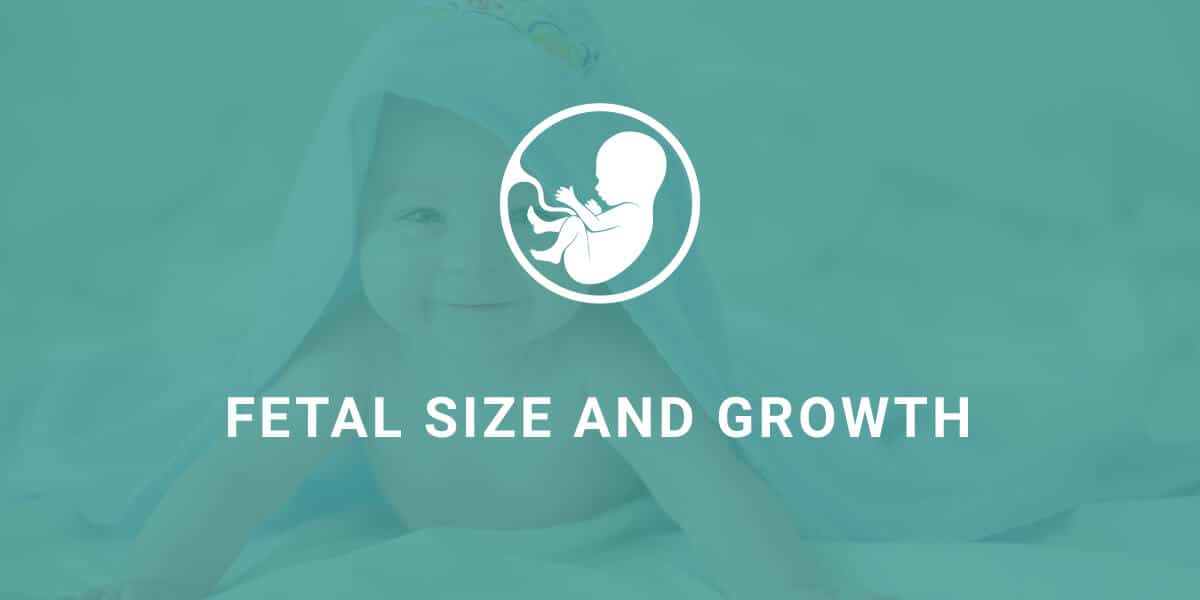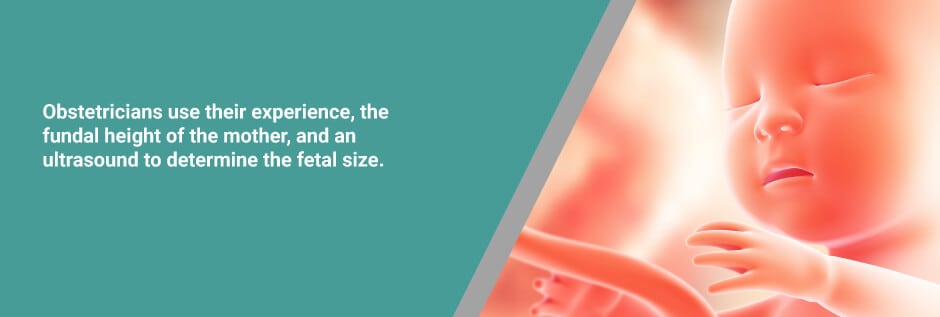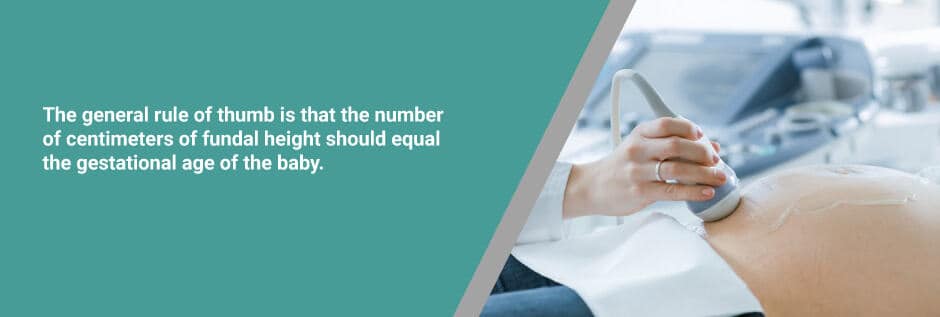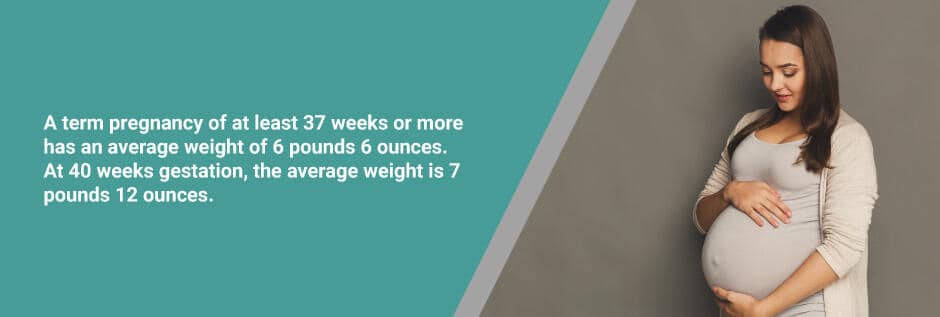
Main Takeaways:
- In certain pregnancies, such as premature or preterm babies, the size and growth of the fetus matters.
- Obstetricians use their experience, the fundal height of the mother, and an ultrasound to determine the fetal size.
- A term pregnancy of at least 37 weeks or more has an average weight of 6 pounds 6 ounces. At 40 weeks gestation, the average weight is 7 pounds 12 ounces.
One of the rituals of pregnancy is estimating the size of the baby. Everyone has an opinion. Does fetal size matter? The answer is that in some situations size or, perhaps more accurately, growth does matter. This article will review why size and fetal growth in a full-term pregnancy are important. The topic of small babies born preterm or prematurely will be addressed in other articles on this website.
How Is Fetal Size and Percentile Determined?
The accurate estimation of fetal size is actually quite difficult.
An obstetrician has three tools he/she can use:
1. Experience
Some obstetricians deliver up to 600 babies a year and with each delivery, they are estimating the size of the baby and comparing their estimates with the actual birth weight. The experience gained with so many deliveries usually results in an obstetrician’s estimate being quite accurate.
2. Fundal Height
With each prenatal visit in the third trimester, the doctor or nurse will measure the mother’s fundus, from her pubic bone to the top of her abdomen. This measurement, in centimeters, is referred to as the fundal height.
The general rule of thumb is that the number of centimeters of fundal height should equal the gestational age of the baby. Therefore, for a pregnancy at 34 weeks gestation, a fundal measurement of 32 cm would suggest a small baby as opposed to a fundal measurement of 36 cm which would suggest a larger baby.
3. Obstetrical Ultrasound
On occasion, a healthcare professional may order an obstetrical ultrasound in the third trimester. The ultrasound technician will measure the size of the baby’s head circumference, abdominal circumference, femur length, and the diameter of the fetal skull. Those measurements can then be used to calculate a rough estimate of the size of the baby.
Why Does Fetal Size Matter?
A term pregnancy refers to a birth of at least 37 weeks or more. The average weight of a baby born at 37 weeks is 2,900 grams (6 pounds 6 ounces). Three weeks later, at 40 weeks gestation, the average weight is 3,550 grams (7 pounds 12 ounces).
For the vast majority of babies, whether they weigh above or below average has no effect on their health and well-being. In some fetal size cases, however, a fetus that is small or very big can give rise to some concerns.
Small Babies
A baby that weighs less than the 10th percentile for that gestational age is called a “small for gestational age” baby. The 10th percentile for a baby born at 40 weeks gestation is 2,900 grams (6 pounds 6 ounces).
Small for gestational age babies can be diagnosed prior to birth based initially upon fundal measurements and the obstetrician’s experience and then confirmed through ultrasound examinations, sometimes repeated every 2 – 3 weeks during the pregnancy. The fact that a fetus is small for gestational age may mean that the fetus is developing appropriately and is simply going to be a small baby.
Intrauterine Growth Restriction (IUGR)
One area of concern is when the baby is not growing at the expected rate. This is a condition referred to as intrauterine growth restriction. Intrauterine growth restriction, or IUGR, is caused by the fetus not receiving the appropriate nutrients in utero for proper growth.
This can occur during the course of the pregnancy or can first become apparent in the third trimester. The diagnosis of IUGR is made by way of ultrasound examination (usually serial ultrasound examinations) or by Doppler flow studies. Doppler flow studies are a type of ultrasound examination that measures the blood flow in the umbilical artery.
The general rule of thumb is that a fetus diagnosed with IUGR should be delivered if the gestational age is 37 weeks or more on the theory that the fetus can receive better nutrition outside of the womb rather than inside the womb. A fetus with IUGR is less able to tolerate the stress of labor.
Studies have shown that the highest risk factor, by far, for neonatal brain injury is IUGR where the baby weighed less than the third percentile. A diagnosis of IUGR, which is known by the healthcare providers, allows them to more safely manage the labor, recognizing the reduced tolerance of the fetus.
Large Babies
A large for gestational age baby is a baby that weighs more than the 90th percentile for his or her gestational age. A baby born at 40 weeks that weighs more than 4,200 grams (9 pounds 4 ounces) is large for gestational age baby. The 97th percentile is 4,550 grams (10 pounds).
It is reported that the largest baby ever born was a baby weighing 22 pounds. This baby was born in Ohio in 1879.
The medical term that is sometimes used to refer to a large for gestational age baby is macrosomia. A large for gestational age baby can be diagnosed by the obstetrician’s experience, fundal measurements, and ultrasound.
The major fetal size concern that arises when a fetus is diagnosed as being large for gestational age is the possibility that the shoulder of the fetus may become stuck in the birth canal during a natural delivery. This is an obstetrical emergency called shoulder dystocia. It makes sense that the larger the fetus, the more likely the possibility that he or she will become stuck during the delivery.
There are many reasons why a baby may be large for gestational age. Genetics play a significant role, as do such things as the mother having diabetes before pregnancy or developing diabetes during pregnancy. Further, as pregnancies go beyond 40 weeks, the fetus continues to grow.
Conclusions About Fetal Size During Pregnancy
An important part of the care provided by family physicians, midwives, and obstetricians in the third trimester is to monitor fetal size and, if necessary, take steps to minimize those risks to the fetus resulting from being too small or too big.
If your child was injured during birth and you believe that the injuries were due to a medical professional’s negligence, contact us today.

Susanne Raab is a lawyer at Pacific Medical Law, and an advocate for people living with disabilities. She has been selected for inclusion by her peers in Best Lawyers in Canada in the area of Medical Negligence and is recognized as a leading practitioner in the Canadian Legal Lexpert® Directory in medical malpractice. Susanne is also a Fellow of the Litigation Counsel of America, an honorary trial lawyer society whose membership is limited to less than one-half of one percent of North American lawyers, judges and scholars.








